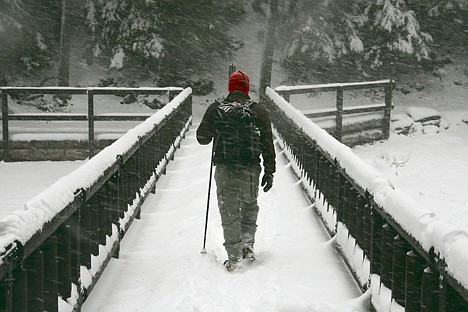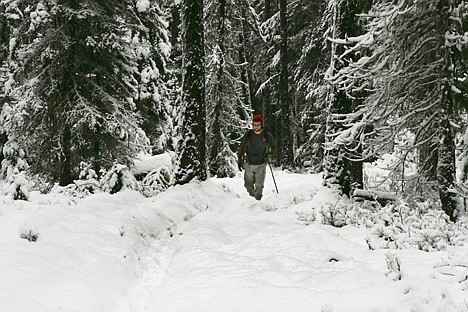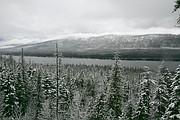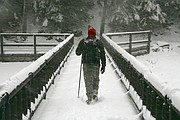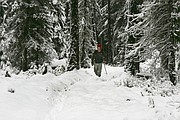Snowfall and solitude
Long before we embarked, while still debating the wisdom of a late-season hiking trip, I told my friend one thing: The scenery would be spectacular.
We were going to Glacier National Park, the crown of the continent, a wild and beautiful place. And even though it was late in the year - practically winter, as it turned out - Glacier, I promised, is always stunning.
I had hoped to visit the park at some point this fall, but schedules never lined up. We finally departed on Nov. 16, a cool and cloudy Tuesday. I had convinced Luke Stocker, a buddy from Coeur d'Alene, to join me, and he was excited about the trek (it would be his first time in Glacier).
We arrived in Hungry Horse, Mont., late in the day, the sky dark and moonless. It was snowing heavily, adding to the few inches already piled up on the frozen ground.
"Who would've thought a place called Glacier would be so cold?" I asked Luke.
Indeed, the night was frosty. Temperatures must have been in the low teens. Our prospects looked grim.
An inauspicious morning
I opened the motel door and felt a gust of arctic air. It was still snowing, only worse. Yep, I thought, this trip's a bust.
"I don't think we have the gear for this," my friend said.
No, we did not. Defeated by the elements, Luke walked down to the office and booked a second night in the motel.
We woke early that morning, but the sun rises late this time of year. Finally, as the light changed from black to battleship gray, I nudged my SUV into gear and drove toward West Glacier.
"OK, Luke," I said, "get ready to see the most famous vista in the park: the view from Apgar over Lake McDonald."
Bustling in the summertime, Apgar Village was deserted that day. Not even the gift shops, those happy oases of tacky trinkets, had unlocked their doors. It was a depressing scene.
We walked to the lake shore and saw absolutely nothing.
"I swear, Luke, this view is beautiful," I said. "Sorry."
Luke nodded. He had expected grandeur, wild magnificence, but instead we gazed upon a dense cloud, a gray mass of blowing snow that hovered over the lake like smoke. The shoreline was barely visible, and the high mountains that ring Lake McDonald - some of the most impressive spires in all of Glacier - were entirely obscured. It didn't look like the postcards.
Undaunted, we were determined to make something of the day. After speaking with a friendly ranger, we headed for the Avalanche Lake trail on the east side of Going-to-the-Sun Road.
The drive was not treacherous. The road was very curvy, and I had to steer carefully to avoid dumping the car into Lake McDonald, but the asphalt was plowed and the 15 miles up to Avalanche passed easily.
An unexpected trek
The best thing about a winter hike, Luke told me, is the silence.
And silence we had found - haunting quiet, complete solitude. Snowflakes fell softly on the slippery trail, filling our tracks as we left them behind. A small stream to our left, gin-clear and rambunctious, slid between ice-covered rocks and tumbled downhill. High above, mountains disappeared into gray clouds.
To see Glacier this way, to be alone with the park, was why we had come to Montana. We barely spoke; there was no need for words. The subtle sounds of our movement, the crunch of boots on powdery snow, the clank of a ski pole, seemed dissonant and out of place, unnatural. It was as if we were treading upon absolute wilderness.
This was all an illusion, of course. The forest was certainly pristine, but we were in Glacier National Park, hiking a very well-traveled course toward Avalanche Lake. Considering the size of the park, the hundreds of miles of hiking trails, we were very much on the beaten path. Still, it was easy to imagine that we were the first explorers to ever penetrate that cold, wild country.
Our snow boots were heavy, our warm clothing cumbersome. Before long we were shedding layers. The trail was slick but easy to follow, climbing gradually toward our destination. We smiled and chattered, enjoying ourselves. After two casual miles we reached Avalanche Lake, a dark body of water surrounded by a cirque of windswept ridges.
According to legend (and the signpost at the trailhead), a local Native American tribe once scaled the cliffs above Avalanche Lake using ropes and brute force. That seemed a tad extreme, so Luke and I decided to circle the lake instead.
Half a mile down the shoreline we began trudging through good-sized drifts. The powder was at least a foot deep on the east end of the lake, maybe more. We bushwacked along the shoreline for about 30 minutes, exploring small, frozen creeks that rambled down the ice-glazed cliffs. Snow fell from a metal sky, and the mountains were still veiled in gray.
With daylight waning and our clothes beginning to freeze, it was time for the long walk back to the car.
A day to remember
Next morning dawned snowy, but the temperature had warmed.
We got another early start and wandered back into Glacier, intent on exploring a steeper, more difficult trail that led toward Snyder Lakes and Sperry Chalet. Going-to-the-Sun was slushier this time, less maintained. The plows had done their work early, but the incessant snow was making our travels more hazardous.
I pulled up to the trailhead near Lake McDonald Lodge. We figured the hike would be a bear; the Snyder Lakes were a voyage, we knew, and most likely very high into the mountains.
The going was fairly steady at first, and we made good time. About a mile from the trailhead the woods opened to the west and we glimpsed Lake McDonald, dark and calm in the valley below. The air was clear and we could see across the lake, toward the far peaks of the North Fork region, where several years before a huge wildfire had scarred the land. The trees were all barren now, colorless, like a forest built of toothpicks.
Switchbacks slowed our progress as the route continued to ascend. The mossy, cedar-filled forest, so characteristic of the lower Lake McDonald region, had gradually changed with elevation, giving way to thinner species like lodgepole and larch.
We reached a fork, and a decision: Head due east toward Sperry, a destination many miles away, or turn left and set a course for Snyder Lakes. We chose the latter, and almost immediately sunk into deep, fluffy snow. The wind was blowing harder; it seemed a true storm was rolling in. We plunged gamely forward, leaning into the climb, breathing hard, treading carefully around buried rocks and roots, one slow step at a time.
Arriving at a sheltered grove of trees, we stopped for lunch. Even there, under the protective layering of pine boughs, the wind chilled us to the bone. The jackets and sweaters we had carelessly shucked during the climb were quickly reapplied.
We felt the cold growing meaner, the snow falling faster. After a brief powwow, Luke and I agreed our best choice was to turn back.
The descent was not difficult. Of course, the weather cleared as we neared the valley floor, and when we reached the SUV the sun showed itself for the first time in two days.
We were damp, cold and smelled like a locker room, but in truth our journey through Glacier had not been especially difficult. Aside from our brief sojourn at Avalanche Lake, we had stayed on trails that were easy to navigate. The hiking was strenuous but not overly tiresome. Even the cold was bearable.
In fact, I'd say the driving conditions were more dangerous than the hikes themselves.
What made this trek special, though, was that wonderful feeling of remoteness. We saw only two other hikers on the trail to Avalanche Lake, and none the next day. We watched snow clouds darken the sky and shroud the mountain tops. We had re-discovered solitude.
Luke and I said goodbye to the park. On the way out, with the weather finally clearing up, we stole one last look at the mighty lake and the high mountains beyond.
The scenery, as I had promised, was simply spectacular.



